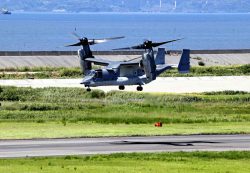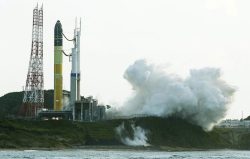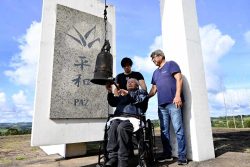
A Metro train seen from Gravelly Point in Arlington, Va., with D.C. in the background.
15:40 JST, August 10, 2024
The Washington area’s Metro transit system is inching toward financial catastrophe, threatening the region’s quality of life and its efforts to lift up the poor, address climate change and spur a post-covid economic revival.
Billions of federal pandemic-relief dollars are now nearly gone, and the “nation’s subway,” as some boosters call it, is facing massive deficits far into the future.
Local jurisdictions agreed this year to cover much of a vast budget shortfall for the fiscal year that started July 1, staving off drastic cuts that would have shut down 10 rail stations and half of Metrobus lines to close a $750 million gap in Metro’s $2.4 billion operating budget. The infusion prevented a “death spiral,” Metro said.
But that was all just a warm-up.
Annual operating deficits of up to a billion dollars are looming in the coming years, Metro officials said, which will require dire cuts or new funds.
Metro will also hit a critical debt ceiling in 2028, exhausting a dedicated funding stream it has used to borrow billions for infrastructure repairs and posing safety risks in the long run, they said.
Transit agencies around the country are in trouble. New York’s subway is in a multibillion-dollar hole after Gov. Kathy Hochul (D) halted a congestion pricing plan that would have charged drivers headed into part of Manhattan. Chicago, Boston and other cities are facing major deficits.
But the Washington region has special challenges. One of Metro’s biggest strengths – its sprawling, jurisdiction-crossing design – is also a particular vulnerability.
The Washington Metropolitan Area Transit Authority is overseen and funded each year by a hodgepodge of governments and officials with varied priorities. It is unclear whether they can agree on how to pay for the system’s long-term success or whether they even trust Metro enough with taxpayer dollars to try.
One problem, Metro says, is that unlike many major transit agencies, it does not receive dedicated funding for its operations and must seek a new pot of money each year from local and state officials, leaving it in perpetual uncertainty. Another dilemma is how to handle soaring personnel costs.
Fares would need to jump more than 500 percent to address the kind of deficits the agency has faced, according to a Metro presentation last year, which contemplated a $19.35 one-way fare to Metro Center from Bethesda, Md. – or $32.70 from Ashburn, Va.
Metro would never hike fares that high because they would instantly decimate ridership, so slashing service would be more realistic. But that, too, would lead to a downward spiral, Metro officials said.
Either it’s “death by a thousand cuts or it’s death by a big sword,” said Metro General Manager Randy Clarke, describing an “existential” threat.
“If we had to cut 20, 30, 40, 50 percent of the service … we’re done for a decade or more. You can’t recover from that,” Clarke said. Laid-off mechanics would take jobs elsewhere, train frequencies would drop, people and businesses would stop moving near Metro, climate goals would become out of reach, GDP would fall. “All of that kind of collapses on itself,” Clarke said.
Clarke – who as head of Austin’s transit authority helped secure a property tax increase to expand the system – says he is optimistic. After years of investment, riders are giving Metrorail high marks. Clarke said he’s “100 percent all-in that this region is actually going to solve” the problem of a lack of dedicated Metro funding.
But if he’s wrong, “the people that literally need the system most are the most hurt,” Clarke said. That pain is sometimes what stirs action, he said, adding, “We shouldn’t do that, but … a whole city has to flood before we build flood walls sometimes.”
– – –
What’s causing the budget problems
The flood warnings sounded early.
Less than a decade after President Lyndon B. Johnson, who signed the law creating Metro, gazed from a mock-up Metro car on the White House lawn in 1968, experts were warning that the system was built on a faulty foundation.
A 1976 report from the Washington Center for Metropolitan Studies – issued months after rail service began – warned of Metro’s fiscal peril and called for a regionwide gas tax to fund it. But that tax was never adopted.
Paul Skoutelas, CEO of the American Public Transportation Association, said WMATA is too complex a system to be operating “hand to mouth,” trying to eke out a consensus among multiple jurisdictions on what Metro can and should spend each year.
In May, Metro and the Metropolitan Washington Council of Governments launched an effort called DMVMoves to rethink the region’s disjointed transit management. The idea is to better coordinate the work of 14 transit agencies and tackle funding challenges to create a world-class network.
Metro poses the toughest challenge.
D.C. gave Metro an extra $200 million to help avoid this year’s crisis, but “we cannot come up with 250 the year after, and 300 year after that, 400 the year after that,” D.C. Council Chairman Phil Mendelson (D) said. “That’s just not sustainable for the District, nor is it for any of the other jurisdictions.”
Yet that’s more or less what will be required if the region can’t control costs and come up with a dedicated funding source.
A complicated pileup of factors has contributed to Metro’s financial problems. Some have been outside the agency’s control, such as soaring inflation. Metro is also reliant on a federal workforce that continues to work from home in large numbers.
But many cost increases stem from policy choices, including expanding the system with the lightly used Silver Line, seen as an economic driver for Northern Virginia.
The biggest item in Metro’s operating budget is personnel costs, which have risen sharply.
In December 2019, Metro’s board of directors approved a four-year collective bargaining agreement with the Amalgamated Transit Union Local 689, which represents more than 9,000 Metro train and bus operators, station managers, mechanics, custodians and others. It included a 1 percent bonus wage increase for workers if rail and bus ridership increased by at least 2 percent from one year to the next.
Then the world was upended.
The pandemic slashed Metrorail ridership by more than 90 percent. After the system hit bottom, 2 percent growth has been a cinch. Workers got their bonus, which cost the agency $5.8 million in 2023 alone, even though ridership remains down.
The collective bargaining agreement also came with an unlimited cost-of-living adjustment as inflation soared. That was on top of 2.5 percent raises over three years.
All told, ATU members received a raise of more than 10 percent in fiscal year 2023.
The cost of employee wages, salaries and benefits rose from $1.4 billion in 2022 to $1.8 billion in 2023, according to Metro data, accounting for more than two-thirds of the operating budget.
Kevin Donahue, D.C.’s city administrator, said the 10 percent wage hike dwarfs increases of roughly 2 to 4 percent for most city workers. It was “more wage growth in one year than I might have a police officer or firefighter or schoolteacher see over the course of a three-year contract,” Donahue said. “There’s a fairness question there.”
And a sustainability question. “You can’t make the math work long term,” Donahue said.
Matthew Girardi, a senior political official at the ATU Local 689, bristled at the notion that worker pay was responsible for Metro’s financial problems. During the depths of covid, members of the union – which is negotiating a new contract – were getting sick and dying while politicians were quarantining out of danger, he said.
“They didn’t have any problem calling us pandemic heroes while we were running those trains and running those buses. But as soon as it came time to actually pay us, for making sure that we were keeping up with just the cost of living … it seems like they’re happy to demagogue on that point and say that it’s unsustainable,” Girardi said. “It’s really despicable.”
– – –
How to fix it and why that’s so hard
Among the options being floated to fund Metro long-term: a regional sales tax, higher taxes on properties near Metrorail stations and shifting funds from highway expansion projects. All would face a political gantlet.
Virginia Transportation Secretary Shep Miller said Metro is vital but must be sustainable.
“WMATA’s total budget has grown significantly faster than incomes in Virginia since 2019, and it is now the most expensive major heavy rail system to operate in the country,” Miller said in a statement. “This trend – driven primarily by costs related to overhead, not service – does not bode well for the long term.”
Virginia officials cited 2022 federal data showing Metro had higher costs per mile of train service than other major rail systems. Metro countered that in 2022, it was grappling with covid and lasting disruptions from a derailment. The per-mile cost is projected to drop by half this year, putting it in line with other systems, Metro said.
Overall, Metro’s operating budget has grown an average of 4.8 percent from 2019 to 2024, the agency said.
Maryland Transportation Secretary Paul J. Wiedefeld, Metro’s former general manager, said there is an “almost stereotypical response” regarding labor issues at Metro – that people are inclined to find worker wages “astronomical” where in reality “they’re not.”
“What they negotiate, they deserve, from my perspective. … It’s not an easy job,” Wiedefeld said. “Obviously, we’ve got to do it within what we can reasonably afford.”
A group of senior government officials from across the region scoured Metro’s finances last year, and their conclusion was blunt.
“The WMATA fiscal model is unsustainable, with the future gap in operating and capital costs, more than current revenues and subsidies, totaling more than $1.25 billion annually,” they wrote, with some regional officials saying the gap could get much bigger.
Clarke suggested that an “appropriate accountability board” could oversee spending as part of a dedicated-funding deal.
Or more drastic measures might be needed, he said – possibly even killing off the agency he runs.
“If that means … WMATA doesn’t exist and it’s blown up and it’s something different, no skin off Randy’s back,” Clarke said. “We should do what’s right and stop kicking the can down the road.”
"News Services" POPULAR ARTICLE
-

Trump Announces Trade Deal with Japan, Including 15% Tariff (UPDATE 1)
-
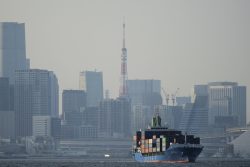
Trump to Put 25% Tariffs on Japan and South Korea, New Import Taxes on 12 Other Nations
-

Japan’s Nikkei Stock Average Soars to One-Year Peak on Trade Deal; Bonds Slide
-

Japan’s Nikkei Stock Average Falls as Traders Lock in Gains after US Trade Deal Rally (UPDATE 1)
-

South Korea, Japan and US Conduct Air Drill as Defence Chiefs Meet
JN ACCESS RANKING
-

Lawson to Offer Car Camping Service at Select Stores; 6 Chiba Stores to Offer Service from Monday
-
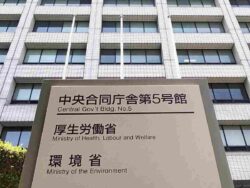
Japan Real Wages Fall for 5th Month in May
-

New Banknotes Account for Only 30% of All Bills in Circulation; Increased Use of Cashless Payments Seen as Cause of Slow Adoption Rate
-

Govt Mandates Collecting, Recycling of Some Devices with Lithium-Ion Batteries Amid Fire Concerns
-

Typhoon Nari Approaching Japan’s Kanto Region; Heavy Rain, Strong Wind Expected on Monday





